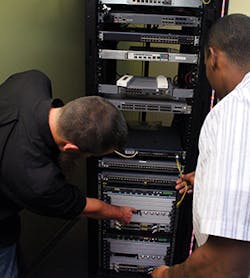Network Evolution Expectations 2019
For many, this time of year is often a time of both reflection of the past year and planning for the new one. It’s hard to believe that we are already nearing 20 years into the 2000’s. When I think back on 20 years, I can’t help but think of all the changes we have seen in this new millennia. Heck, with Netflix, Facebook, Amazon Prime, and Instacart, we barely have to leave our homes now! The world was quite different than it is now, and, likewise, it should be no surprise that so was the telecommunications industry.
We have since entered a world where nearly everyone and every thing is connected. Back in 2000, it would have been unimaginable to be able to turn my house lights on or control my car from anywhere in the world just by using my phone! Yet, the ability to video chat with my wife and kids from wherever I am while traveling is now a commonplace thing that I, along with many of you, do often.
At the turn of the century, I’m willing to wager that many of you already had some sort of Internet connection. However, I bet the connection you had then is nothing like what you have now in terms of speed. Like most of us, the 768k DSL home connection I had at the time is nothing like the 100Mbps connection I currently enjoy. According to the FCC, there were only about 2 million Internet connections at the end of 1999 with the dominant way of accessing the Internet being 56kbps dial-up services (58%). Only a small amount (18%) connected with ADSL services ranging from 128kbps up to a whopping 1.5Mbps. The FCC now reports that we have broadband service (25Mbps or greater download speed) available to over 92% of all Americans, and it is not uncommon for consumers to have 100Mbps, 250Mbps, or even 1Gbps connections.
Another difference? You probably were limited on where you could use your computer, most likely because you had to plug it in to use the Internet, even if it was a laptop, as Wi-Fi products were only starting to be released 20 years ago. As I write this today, I don’t even have an Ethernet port on my MacBook, and can’t even think of the last time I couldn’t get Wi-Fi somehow. Wireless connections have clearly become the preferred way for all of us to connect our devices.
2019 Expectations
While reflecting on the past can be entertaining, and sometimes comical, I would like to turn our attention to the future and what we should expect to see over the coming years. Obvious or not, every one of the comparisons I have made here all have driven by, or been enabled by, the telecommunications industry. That symbiotic relationship between the industry and consumer demand will certainly continue. As I look at the future, I believe there will be 3 principal drivers of network evolution for our industry: Capacity Demands, Real-Time Applications, and 5G.
DRIVER #1:
CAPACITY DEMANDS
End users’ continually increasing capacity demands should come as no surprise to anyone, whether they are in this industry or not. We have seen Internet traffic grow at an exponential rate, driven by content consumption and additional users coming online. While the developed world no longer has an abundance of new Internet users connecting, the traffic growth will continue. Television is shifting rapidly from the old Cable/Satellite model to one of on-demand content. As more and more users start to consume video content purely on their Internet connection, the networks will experience some of the highest capacity strains ever.
Additionally, Cloud services are becoming increasingly more common. According to Gartner, the worldwide public Cloud services market is projected to grow by nearly 50% over the next 2 years. Cloud-based services are dependent on the pathway to the Cloud. Without a good connection, Clouds don’t work!
All of that video and Cloud growth will translate into tremendous network demands for all of us in both network access capacity and backbone congestion management. Copper technologies like xDSL or G.fast will have very limited use cases, and should only be deployed surgically with an understanding that they are shorter-term solutions. In the end, fiber will be required.
Every effort to get fiber deeper and more densely deployed will lead to better ability to handle the high capacity needs of an over-the-top video and Cloud-driven network. Those who move to a 100% fiber optic network will be able to support whatever capacity drivers come next from market disrupters we have yet to experience.
InvisiLight® Solution for Deploying Fiber
April 2, 2022Go to Market Faster. Speed up Network Deployment
April 2, 2022Episode 10: Fiber Optic Closure Specs Explained…
April 1, 2022Food for Thought from Our 2022 ICT Visionaries
April 1, 2022DRIVER #2:
REAL-TIME APPLICATIONS
Real-time applications will require a very different approach to network planning and operations than in the past. Somewhat related to the shift to Cloud-based services, many of the growing types of applications (augmented reality, gaming, video, digital assistants) require very low network latency to function well. Some of these applications need latencies less than 30 milliseconds — that’s 0.03 seconds! While there is no universal fits-all of what low latency is, lower is always better.
Network deployment over the past 15 years has been laser-focused on increasing capacity to customers. The demands of Internet access applications like streaming video have required a lot of capacity "catch up" from most network operators. However, a high-capacity, high-latency connection will start to become as much of a problem as a capacity-constrained connection. For example, Amazon’s Alexa digital assistant may have plenty of network capacity to communicate with the Amazon servers which power her. But, if the network latency is too high, the server connection will continually time out, rendering her useless.
In my experience, the effort to solve capacity problems has resulted in many different network nodes being added and fiber routes deployed or used in any manner possible. This is often caused by an attempt to lower the cost of solving the capacity problem, often using existing fiber paths in any way possible, regardless of the route. Unfortunately, the effort of fixing a capacity problem can lead to creating a new problem: latency. The resulting additional electronic touchpoints and inefficient fiber path routing are the culprit.
The new network evolution approach needs to be focused on eliminating intermediate electronics and using or constructing as direct of a fiber path as possible. Please also note that this approach should not only be focused on the access portion of the network, but also the core and upstream Internet components as well. Like plumbing, the goal is to have as smooth and least disruptive network path as possible!
DRIVER #3:
5G
5G is the often talked about, yet misunderstood, successor to 4G, and the driver of network evolution throughout 2019 and beyond. Verizon already went live with 5G in one US market (as of this writing in October 2018). Two additional markets will follow in Q1 2019. Throughout 2019, we will no doubt see the other carriers follow suit and additional 5G areas will be launched.
While this may seem obvious to much of the readership here, 5G is dependent on a key aspect of our networks: fiber density. Being part of the 5G deployment in 2019 and beyond requires an abundance of dark fiber. So, not only will there need to be more fiber routes, but those fiber routes will need to be large capacity cables to allow for the many dark fiber connections required by the wireless carriers deploying those 5G serving devices.
Want to win in this new data driven frontier? Strive to deploy a high-capacity, low-latency, and high-density fiber optic network. It’s not rocket science, right? As simple as it sounds, I see time and again that this clear recipe to success is not followed. When it’s not followed, it’s usually due to an effort to solve a short-term problem (lack of capital, time, etc.) at the expense of the future goals.
In 2019, I challenge you to see the bigger vision and have the conviction to follow through with it. You will thank me in the end. And even more importantly, your customers will thank YOU.
About the Author






